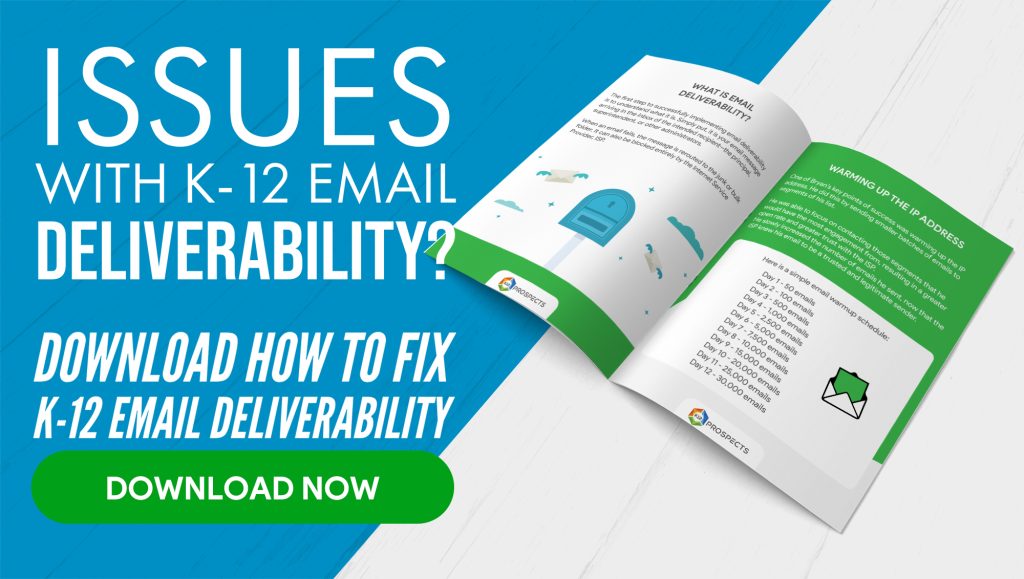Email Deliverability Problems That Kill K-12 Marketing Campaigns


You spend a lot of time crafting your emails. You’ve sourced the best leads, you’ve attracted the right audience, and you have value worth sharing. How can you make sure your emails are actually being delivered?
You want to share content that converts, but crafting the perfect email is only have the battle. You also need to position your campaigns so they actually reach your users inboxes and avoid spam filters. Today, over 48% of all global emails are marketed as junk, and that means it’s more important than ever to be vigilant, especially in K-12 marketing where being trustworthy is key.
What exactly is email deliverability? It’s how you measure the success of your emails reaching an inbox without being marked as spam or bouncing. There are a number of common email deliverability problems, and it’s time you learn the best way to avoid them so your emails can hit the mark every time.
1. Sending From the Wrong Email Address
You need to pay close attention to every part of your email campaign, and that includes your send address. If you’re using a from address that’s from a domain other than the one you own, you’re much more likely to be marked as spam.
The same is true for free email addresses like those from Yahoo, Gmail, or Hotmail. Any bulk emails you send should be from an email address at your own domain or subdomain. Not only that, but you should use a company address that clearly identifies who you are such as newsletters@company.com. This is the best way to prevent spam filters from blocking your emails, and it also helps your audience quickly recognize you.
2. Avoid Spam Flagging Subject Lines
We’ve all seem subject lines that seem to scream “SPAM” without even needing to open them. Sometimes, we can use these spam flagging lines in our own subjects without realizing it. Email spam filters are always on the lookout for the following:
- ALL CAPITALS
- Excessive punctuation (!!!)
- Special Characters (#$%)
- Unusual symbols
- Including RE or FWD without prior contact
All of these things are a recipe for being caught by a spam filter, so keep them out of your subject line. Instead, be clear and creative. Your subject line should be interesting enough to attract clicks, but it shouldn’t be misleading.
3. Not Segmenting Your Email List
Segmenting is not only vital to the success of your campaign, but it also protects you from being seen as spam. In fact, segmented email campaigns boast an open rate that’s 14.32% higher than non-segmented campaigns.
Doing high-volume sends to your entire email list seemingly out-of-the-blue, can be a red flag for mailbox providers. Instead, focus on segmenting your email list and to release large-release emails in smaller increments.
4. Ignoring a High Bounce Rate
Your bounce rate can really tell you about the health of your email list. There are two main types of bounced emails you need to worry about. The first is known as a hard bounce which happens when an email is invalid or no longer active. The second is a soft bounce, or when a mailbox provider temporarily blocks your emails.
If the email you’re trying to reach simply doesn’t exist, it’s time to find the source of the problem. However, some level of soft bouncing is normal. Ultimately, if you notice your bounce rate is inching over 3%, it’s time to reconsider how you’re getting your email addresses as well as your send strategy.
5. Relying on a Low-Quality List
Finally, one of the biggest problems for K-12 marketers specifically is relying on a low-quality email list. If you don’t have a strategy for finding the right school leaders, administrators, and so on, you’ll continue to experience high bounce rates, spam filters, and other deliverability problems.
You need a highly accurate list which includes only active, interested email addresses straight from the school leaders themselves. When you spend so much time on your email campaigns, you need to make sure they’re actually going to convert.
Are Your K-12 Marketing Emails Deliverable?
If you’re struggling with email deliverability, it might be time to take a look at your list and your strategy. You might be running into one of these common problems above.
You don’t have to settle for emails that don’t actually make it to your prospect’s inbox. Following these tips above and making a change is the best way to supercharge your k-12 marketing email list.

